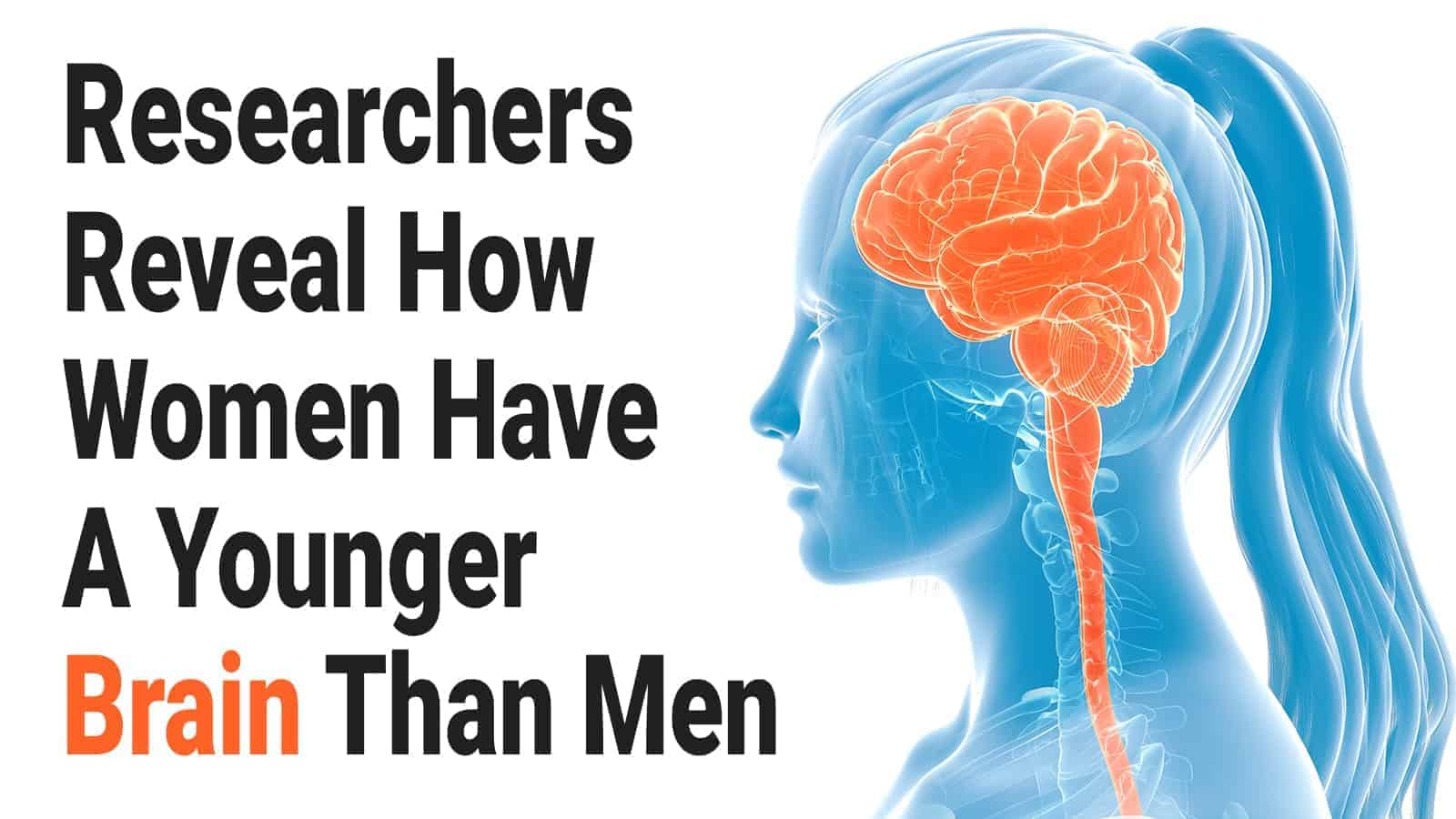Scientists and medical professionals have often cited the biological differences between men and women. Of course, many of these differences are not innate; instead, they are learned and instilled through observation and the world around us. Still, they are differences nonetheless.
One of the most prevalent myths about the differences between men and women has to do with their brain. People often say that men mentally mature five years more slowly than women do, implying that a 23-year-old man may have the same maturity as an 18-year-old woman.
This myth has been disproved many times, and now recent research has come to light that completely flips the switch on this idea. Not only does it, once again, bust that myth, but it also suggests the opposite: that women’s brains are younger than men’s throughout their lives.
But what does this mean? Chances are, it’s not exactly what you think. Here’s the way researchers reveal that women have a younger brain than men.
Researchers Reveal How Women Have A Younger Brain Than Men
1. The Study
This study was performed by a group of researchers with the Washington University School of Medicine, located in St. Louis, Missouri, and published in the Proceedings of the National Academy of Sciences. Here are the names of the researchers who found that women have a younger brain than men, in alphabetical order:
- Andrei G. Vlassenko
- John C. Morris
- Lars E. Couture
- Manu S. Goyal
- Marcus E. Raichle
- Randall J. Bateman
- Tammie L.-S. Benzinger
- Tony J. Durbin
- Tyler M. Blazey
- Yi Su
About the study
Scientists gathered 84 men and 121 women between the ages of 20 and 82 and invited them to take part in a kind of brain scan known as a PET scan, or positron emission tomography. This technique enabled them to measure the flow of certain components through the brain of each participant, especially glucose and oxygen behavior and how they flow and are transported around the brain.
But that’s not all that researchers took a look at. The study also surveyed a process naturally performed by the body called aerobic glycolysis. Glucose, or blood sugar, is converted into energy by many different parts of the body, including the brain. These imaging scans were designed to determine how this energy is created within the brain of each study participant.
Why is aerobic glycolysis such an important part of this study? Well, this process occurs at a higher rate the younger you are. In infants, toddlers, and young children, aerobic glycolysis happens at such a fast rate because it is a way for the brain to develop.
By the time someone reaches their teens, the rate would have dropped a lot, and it gets lower and lower as someone ages. In the elderly, especially those aged 60 and above, the process happens very minimally. This is how this process, which is a form of brain metabolism, is useful in measuring the age of a brain.
2. Methods
Now you know the general overview of the study and its goals. So, let’s look at the methods used to collect and interpret data by the researchers. What they did next was to develop an algorithm on a computer that, based on medical knowledge of brain metabolism and its correlation to age, could view scans and predict the ages of the people’s brains through those imaging tests.
The computer first had to be taught how to do so. First, it was taught the ages of men corresponding with their brain scans. As soon as it learned, it took metabolism data from female imaging scans and began to attempt to predict the ages of the women those scans were from.
Then, the process was reversed. A computer was taught to recognize the ages of women based on their brain scans. Then, it was fed male brain scans and asked to predict what ages the men truly were, based on what it had learned from women’s scans.
So no, this study didn’t draw any conclusions about mental maturity. The point of the study was to find out how physically old the brain is in different sexes – and it certainly succeeded.
3. Findings
In the first run of the computer algorithm, a computer learned the relationship between male brain scans and their ages and attempted to apply this relationship to female brains scans and their ages. The algorithm predicted that the women in question were younger than their male counterparts – up to 3.8 years younger.
In the second run of the computer algorithm, a computer learned the relationship between female brain scans and their ages and attempted to apply this relationship to male brains scans and their ages. The algorithm predicted that the men in question were older than their female counterparts – up to 2.4 years older.
Why did this happen? Apparently, male brains burn off glucose and convert it into energy in ways that make them seem much older than females. You might think that this may be due to age discrepancies, but the men and women who were judged against each other were all the same age as their study partners.
This difference could be seen throughout all age groups, whether the participants were young adults or elderly senior citizens. This suggests that women’s brains never reach the same age as men’s brains metabolically, no matter what. No signs suggested that the gaps in metabolic age narrow or widen over time.
It should be explained, though, that this does not point to mental maturity; it also doesn’t mean that men’s brains naturally age at a faster rate at all. Instead, findings suggest that when men reach adulthood and their brains are no longer attempting the rushed development of infancy, they start their grown-up lives with brains that are already around three years older.
4. What Does This Mean?
So, what do these findings suggest? As of right now, even the researchers who worked on the case do not know. But one thing is for certain – this is a very important study; its findings bring the medical world a step closer to better understanding differences between the sexes.
Researchers theorize that the reason behind these findings could lie in many locations, though there is currently no way to confirm this 100%. These factors could easily influence brain development. The possible explanations for these metabolic age differences include:
a) Exposure
Gender differences may result in individuals be brought up differently. They may face different inflammatory, immunological, and even hormonal environments as they age, causing their brains to adapt to make up for the differences.
b) Sexual differences
The biological differences between men and women could have some impact on how their brains develop. However, much research has suggested that, on average, there is more difference between two people of the same sex than there is a difference between men and women as a whole.
c) Development
Women are known to reach puberty, on average, a little bit before men, though this is not a concrete difference. There are always exceptions to the “rule” and this is not something you can be 100% positive about.
d) Hormonal exposure
We did mention this earlier. This type of exposure can completely change the way the brain develops structurally. It can potentially affect blood flow, too, which goes on to affect brain health.
All people lose some of their cerebral blood flow as they navigate the tumultuous times of puberty. In women, studies have shown they have a lower rate of this flow loss, and they also go through additional aerobic glycolysis – a good amount more than men – during young adulthood. They also don’t lose as many gene expressions when they get older.
It is likely that these findings show one of the reasons that women do not face cognitive decline as often or, sometimes, as severely as men do as they age. However, more research is needed on the subject before anything can be definitively said. Consider, for example, the fact that once they hit 60 years of age, women have a higher chance of developing Alzheimer’s than breast cancer. In fact, Alzheimer’s patients are made up of more women than men.
For right now, there is no indication that this brain youth has any positive effects on a woman’s mental function. That said, this study opens doors to future studies that could shed further light on the subject and improve our understanding of brain disorders and health.
5. Can You Make Your Brain Younger?
After the results of this study, it’d be no surprise if men everywhere try to find ways to add youth to their brains. Sadly, it doesn’t really work that way, but there are known ways that one can improve the overall health of their brain. A healthy brain leads to less negative effects of aging, after all.
Many habits designed to keep the brain healthy can also be used to keep the whole body healthy. Here are some tips you can try:
a) Diet
For most people, heart health leads to brain health. Those who do not consume a heart-healthy diet may fall prey to vascular degeneration, which can have negative effects on the brain.
b) Exercise
Keeping fit and ensuring your body is healthy is a great way to boost brain health because it allows the cells to use glucose in a better way. Plus, exercise has tons of other benefits: it makes you stronger, improves positive thinking, and boosts your overall bodily health.
c) Social interaction
People who maintain some degree of social activeness throughout their life are more likely to avoid mental decline. You don’t have to be the life of the party, but don’t shut yourself away!
d) Engage your mind
Research suggests that doing puzzles can help keep the brain sharp, warding off unwanted degenerative diseases and having overall positive effects on cognition. Stick to puzzles that challenge you – not ones that frustrate you!
Final Thoughts On How Women Have A Younger Brain Than Men
There is still much to be understood about the underlying causes and results of women having younger metabolic brain ages than men. Further research is needed regarding this subject, but it is clear that this study may just be the one to propel our understanding of this topic much further.
For now, focus on taking care of your body and your mind! Maintain positive thinking, practice good habits, and keep your eyes open for further developments regarding the aging of the human brain.

















